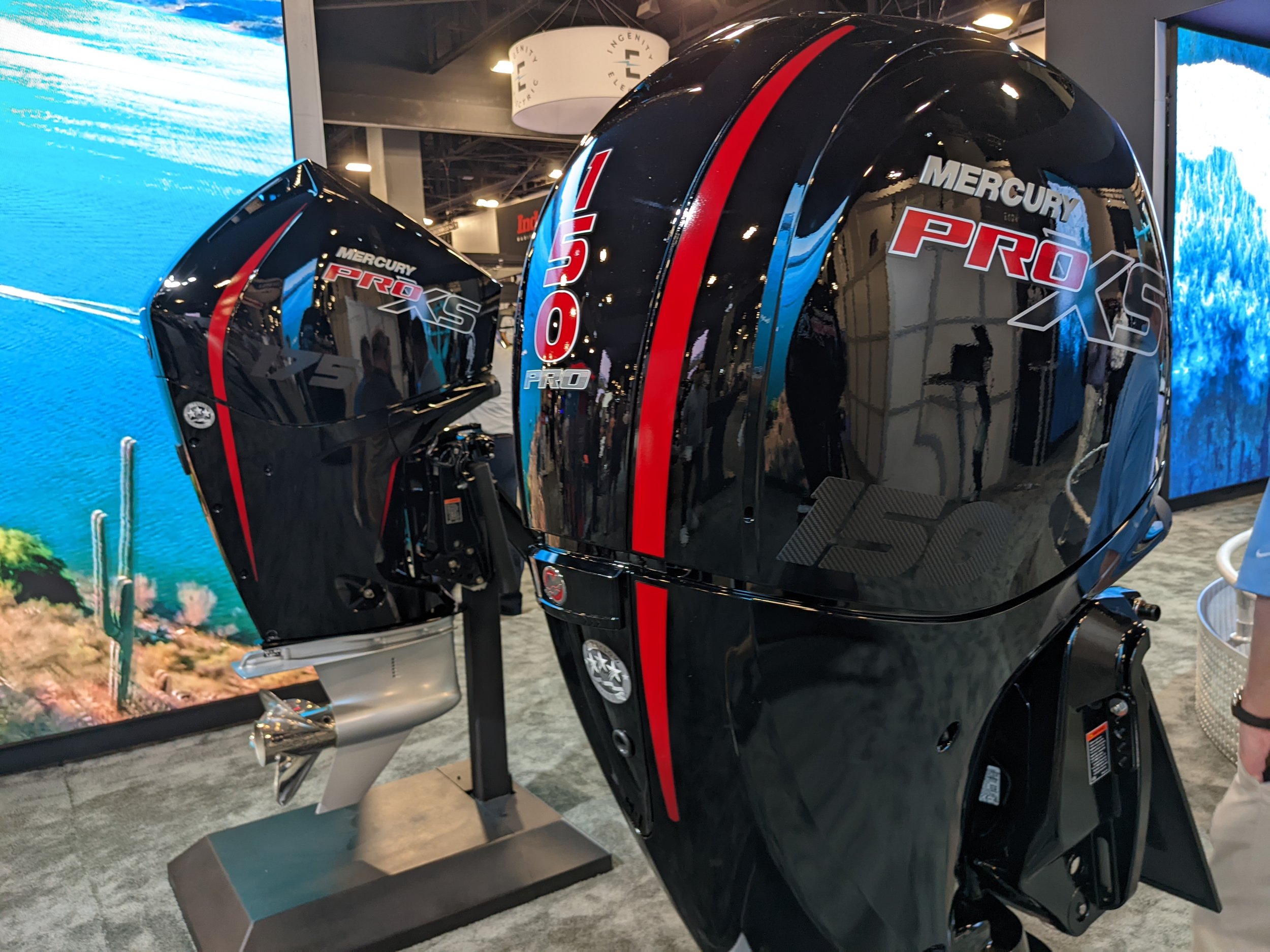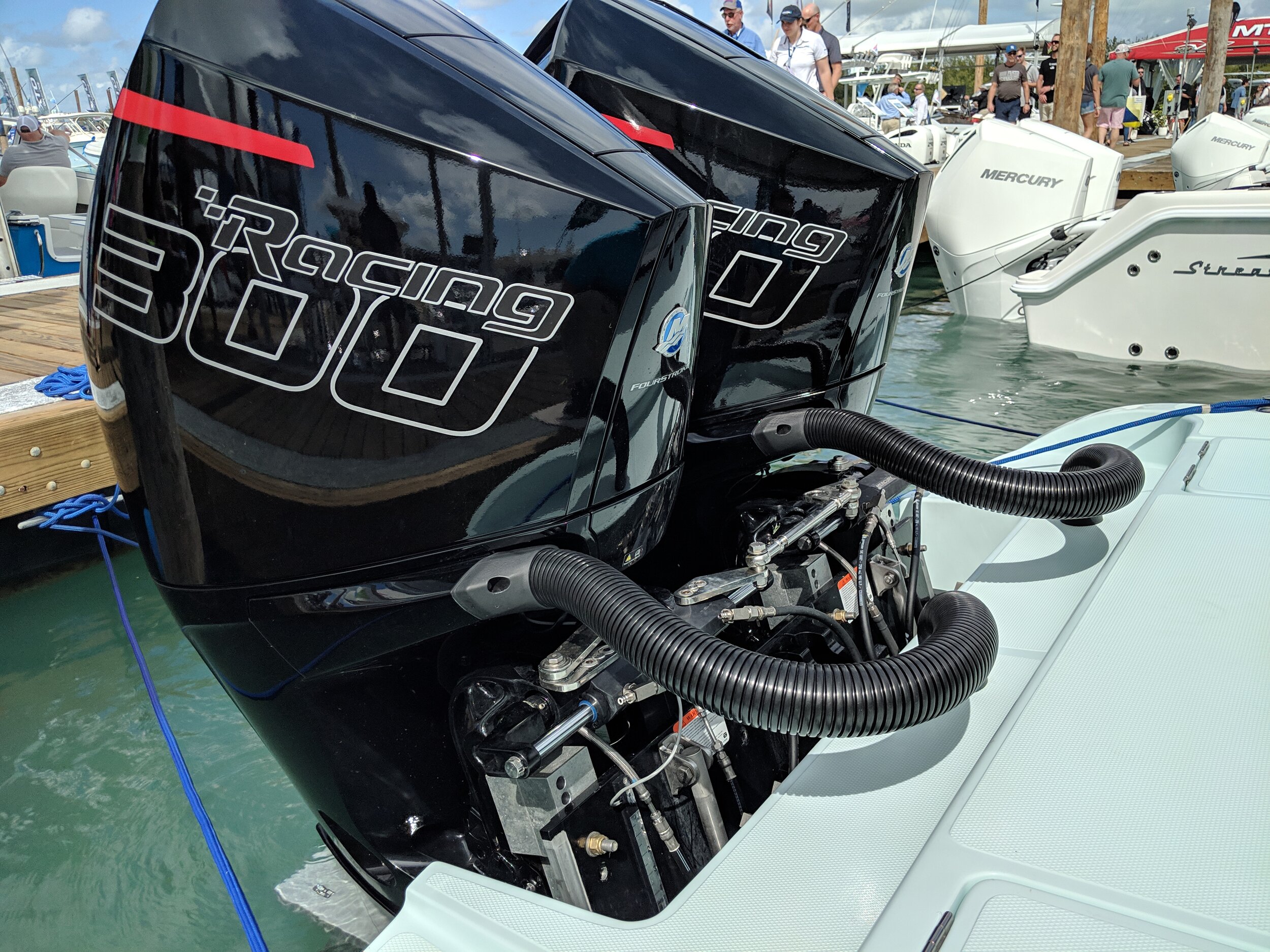Can Suzuki Marine Start Pulling its Weight? The Engine Manufacturer is Missing a Big Market
When it comes to 300 HP outboards, only two companies make a 300 HP with a 20” midsection and only one makes a V6 300. Mercury makes the 300 Verado, ProXS and the Mercury Racing 300R; all sharing the 4.6L V8 platform. Suzuki makes a V6 300 HP with a 20" midsection. Yamaha doesn't offer a 20" 300. Mercury dominates the 300 HP category and is the only manufacturer offering performance options. The question becomes, should Suzuki add performance features to expand their market?
Suzuki has become a popular outboard by offering attractive pricing, great technology and really attacking the repower market. With modern design, a choice of colors and digital controls with all their V6 outboards, you can see the attraction. They don't really offer any performance outboards except for the 200 and 250 SS badged engines that are basically just decal packages, with no distinguishable difference from the other Suzuki models. The SS engines have slightly taller gears but that’s basically it, there are no real performance features.
Suzuki has become popular in certain segments, bay boats and center console mostly, with the repower market being strong as well. They completely miss the semi performance market, thing bass, flats, sport boats.
One issue with the big V6 250 and 300 is that it doesn't have any advantages other than price. Suzuki's philosophy is to use extremely low gears, utilizing an offset drive shaft to centralize the weight of the outboard. Lower gearing can work on really heavy boats that are cruising at low speeds but are a disadvantage on anything performance related. Suzuki also uses a larger gearcase to accommodate larger props, furthering the philosophy of pushing big boats. The extra gear set on the offset drive line adds weight unnecessarily though and doesn’t really have an advantage other than a claim of compactness and less vibration.
Suzuki V6 outboards have a nice gearcase with water pickups on the front and side of the cone. The gear ratio, engine mounts and weight are the real key features you need to compete though.
The gearcase itself looks reasonably hydrodynamic, with a bullet shaped nose and water pickups on the front of the case and on the sides. For the 4 cylinder 200 SS, Suzuki uses the larger V6 case and 2:1 gears. It wouldn't take much for Suzuki to beef up the driveshaft and modify the water intake for more of a surfacing drive. Even though the V6 300 Suzuki revs up to 6,300 RPM, the 2.08 gear ratio hampers it on any reasonably fast boat. Mercury and Mercury Racing offer 1.75:1 gears on the 250 and 300, and 1.60 optionally on the 300R.
You would think a V6 might have a weight advantage over the V8 Mercs, but not really. The 4.0L Suzuki V6 is 578 Lbs, All of the Mercury engines are in the 505 lb to 540 lb range, with the ProXS listed as the lightest. The Yamaha 250 SHO V6 is also heavy at 530+ lbs. These are all pretty close in the real world though, because advertised weight can be slightly off sometimes.
Would Suzuki be wise to rethink the SS models and expand it to the 225, 250 and 300 with a stronger effort in making it a performance engine? Yes. I don't think it would affect Mercury sales as much as it might Yamaha. The V6 4.2 SHO Yamaha are great engine, yet only available with mechanical controls. Yamaha's biggest advantage is the aftermarket parts available to tune the SHO. It really surprises me that Suzuki doesn't put more effort into the SS line or anything performance related at all.
Suzuki has tried to offer a matte black with red on the SS models but it’s style over substance. A nice coherent scheme for the SS line would be good. They have gun metal, matte black and white. The latest gunmetal seen here is pretty nice.
For Suzuki, they should look really closely at their lineup and expanding the SS (or other moniker) to offer taller gear ratios, to compete with Mercury and Yamaha. Their current offering is very limited. The SS starts at 115 HP. Why not make the SS always have a more performance oriented gearcase, slightly different tuning for more RPM, and potentially lose the offset gearing to reduce weight. Performance motor mounts and a lightweight cowl would really differentiate the SS line. The 150 SS is based on the same 4 cylinder as the 200 SS, at 418 Lbs, with a 2.59 gear set which is not very usable. The 200 SS uses a 2:1 ratio. A true performance Suzuki 300 and 250 could really set the tone. Right now the SS line is not competitive in the bass boat world or recreational performance market. Mercury and Yamaha dominate this category with their SHO and ProXS line.
Mercury dominates the semi performance market with the Pro-XS line, adding just the right features, more RPM, great gearcases and higher RPM range. Some are slightly lighter and have stiffer mounts.
Here is how I would reconfigure the Suzuki SS line. First, cohesive design language. Currently they have about 4 different colors and graphics available. Stick to one or two; Suzuki has shown a new gunmetal look, use that. Second, for the SS engines, I would lose the offset driveline and worry about reducing weight and improving the gearcases. Weight, gears and mounts are critical features.
The offset drive shaft allows Suzuki to move the powerhead forward, although the benefits would be dubious with added weight and complexity. A true performance line would focus on weight reduction.
The 115 SS has a 6,300 RPM with a 2.59 ratio, it’s not really differentiated enough from the regular 115, just the 300 RPM increase, I would offer a more competitive 2:1 or 2.08:1 like the competition. The 150 is heavy and also geared wrong, there is no material advantage over the regular 150, I would use the smaller 4 cylinder 140 2.0L engine, tune it to 150+ with a taller gear ratio in the 2.00 range and you’d have the lightest 150 on the market with a 6,300 RPM range. The 200 SS is okay and is reasonably competitive with other 4 cylinder semi performance outboards but that’s the opportunity, why not make it the best 200 semi performance on the market. Lighter, proper gearcase and stiffer motor mounts.
I love 4 cylinder four strokes, they are slimmer and lighter and work on smaller boats. Yamaha has done really well with their SHO 4 cylinders. Suzuki needs to take notes. The Merc 150 Pro-XS, Yamaha 150 and 175 SHO are the ones to beat.
For the big V6, the competition is fierce and Suzuki is not competitive at all. Removing the offset driveline, more robust gearcases with a true low water pickup and a durable 1.25” prop shaft. The 250 SS revs to 6,300 RPM and with a more competitive 1.75 gear ratio could match the Yamaha and Merc. It would need a semi sold mounts and that would really make it closer to the competition. Adding the 300 HP to the SS line with the proper upgrades could really give the SS line a marketable advantage. For some reason the latest 250 SS weighs over 600 Lbs. That’s far too heavy. A 250 and 300 would need to be much closer to 500 lbs to be competitive.
The V6 should have a weight advantage, not be the heaviest on the market.
If your semi performance engine line’s biggest differentiator is the decal, than you are not competing. The engines have to be better in every way with real features.
Suzuki has done an admirable job of becoming a player in the general outboard market, even though they've been around forever and were very early in the four stroke outboard game. If they want to compete for real though, they have to think bigger. More power, more performance, differentiate, expand their market. And the semi performance and performance opportunity is right there.
If Suzuki wants to go beyond the tug boat market, they need to get serious.














